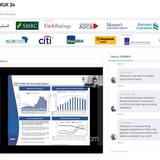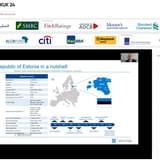Globally, and Eurozone-wide, there is a downturn setting in. If you look at German industrial production, US manufacturing and car sales and similar indicators, they were in positive surprise territory for a few months, but are now looking neutral or negative. This is an environment where many corporates within and outside Turkey will be reluctant or cautious in boosting capital expenditure, which could have negative implications for the country’s capital markets.
“Some of the construction and fixed asset investment expenditure in Turkey is driving above-trend growth, which is sitting between 3-3.5%. If we look at household consumption, we may see some stimulus due to lower interest rates, but you need booms in terms of white goods and car purchases – which are more forward looking and depend more heavily on the perception of what’s ahead over the medium to long-term, rather than what we are seeing month-on-month,” says Tatha Ghose, a senior EM economist at Commerzbank AG.
Inflation is likely to trend downward in 2017 – mirroring the global trend – but if you decompose Turkish inflation, much like what we are seeing more broadly in other emerging markets, it is largely driven by FX pass-through. There is little to no domestically generated inflation; without this pass-through effect, analysts expect we would be looking at 2-3% inflation rather than over 7.5%, where it is currently trending. There are structural rigidities in Turkey that could prevent inflation from coming down rapidly if the US Federal Reserve were to raise rates.
Despite a broader EM rally that gave a boost to the country’s local and hard currency assets from the Spring through to the Summer of 2016, Turkey’s capital markets are largely exposed to the same risks and challenges impacting the broader asset class, with few idiosyncratic nuances.
Geopolitical, and to a limited extent domestic political uncertainties have produced a challenging outlook. There are few concerns about the domestic political environment’s impact on the country’s economy, as the rapid rebound following the July coup attempt attests, but there are concerns externally that key institutions like the Central Bank of Turkey or the country’s banks could be forced into adopting policies that are driven by primarily political considerations.
Overall, Turkey is performing well on a relative basis but poorly on an absolute basis, and much like South Africa has struggled to attract strong fund flows or precipitate a positive outlook on its currency, according to one EM investor.
Fundamentals in a Changing Economy
Turkey has the demographics of a true emerging market. There is significant potential for increased labour force participation among women and youth in the country, which are currently far below peer benchmarks.
Workforce growth has been robust, and job growth has been strong despite the fact that the economy has not grown as quickly in 2016 as in previous years; job growth over the 5-year period ending in July 2016 has averaged 50,000 to 60,000 jobs a month. On a 12-month rolling basis in Q1 2016, the Turkish economy created 847,000 jobs. The services and construction sectors created 683,000 and 140,000 jobs respectively, while the industrial sector reduced employment by 75,000, according to a recent BBVA report.
Turkey is the second largest producer of cars in Europe, the second largest producer of white goods – fridges, TVs, etc., and the largest producer of construction steel.
However, its relative lack of indigenous resources outside the agricultural sector poses a significant challenge for the economy. Over the past 10 years Turkey has geared its economy towards being an outsourcing partner for large countries in the Eurozone, particularly Germany, a transformation that took place before the China-driven commodities boom took place.
Turkey has long been a major producer of grain, cotton, tobacco, grapes, sunflower, pulses, dried and fresh fruit, tea and small ruminants, though inflation and high interest rates contribute to a subdued outlook for the sector. Exports, which to Russia and Iraq have dropped 63% and 21% this year respectively according to the OECD, have also been weakened by a sharp contraction in regional market demand – due to a combination of geopolitical factors and warfare. Agricultural exports to MENA, Russia and Sub-Saharan Africa should improve slightly next year, Ghose explains.
Turkey’s interest rate-sensitive sectors should perform well because they are the main beneficiaries of low interest rates, increased bank lending, and the easing of macro-prudential norms for lending. These sectors include domestic construction and engineering services, local sales of white goods, and to some extent automotive – though some analysts believe the latter is peaking. Trade with the Eurozone is forecast to slow in 2017, with European demand for goods and Eurozone-generated production deals likely to drop off.
Financial services are forecast to perform well in 2017 as banking credit quality remains strong, coupled with a recent push to boost domestic lending activities. This may be countered to some extent by squeezing margins as a result of caps imposed by legislators, like the recently introduced mortgage lending rate ceilings, but analysts expect borrowing from both banks and the debt capital markets to increase next year.
Tourism, a significant driver of output in Turkey, looks likely to persist as a dark spot in the near term, largely the result of geopolitical instability and domestic terrorism concerns. The domestic tourism output is subdued or neutral, while foreign tourism is looking likely to perform poorly. It will take some time for confidence to recover before the sector recovers.
A Foggy Outlook
The country’s relatively young population is undoubtedly one of the leading drivers of investment in Turkey – and a main driver of the country’s GDP growth. Turkey’s youth is increasingly finding employment in the service and technology driven sectors (FinTech, for instance), which are both putting in double-digit growth, and which has the potential to produce a much needed structural realignment of the Turkish economy.
For the time being, structural challenges remain. A significant portion of the Turkish economy sees the country’s companies create marginal value by producing goods with imported materials and selling them for a premium, particularly in Europe and increasingly in the US, including automotive goods, furniture, white goods and electronics. But this model struggles to keep up with the swings in commodity prices relative to flatter pricing on end products, which contributes to the growing current account deficit. Additionally, Turkey imports over 95% of the natural gas and 89% of the oil it consumes; energy is the leading contributor to the country’s current account deficit, exacerbated by the rising cost of hydrocarbons and a foggy outlook for the global energy sector. These are among some of the most significant structural challenges imposed on the country’s current account.
Growth is on track to reach just under 4% this year, edging downward slightly in 2017. If structural reforms proceed, and the domestic and regional political environment stabilises, stronger private investment, domestic demand and a boost in exports could change the outlook for the better. Over the long term, demographics will play the most influential role of all, with the country’s young workforce shifting into higher-margin services, modernising the Turkish economy.
The key question is: how quickly can Turkey shift away from its dependence on innovation from outside its borders? The country’s recent moves (“Law on Supporting Investments on Project Basis and Amending Certain Laws and Decree Laws”) to incentivise domestic R&D, court technology firms, stimulate ICT investment, and improve access to universities are steps in the right direction, but the answer ultimately lies with the next generation of the Turkish workforce.









